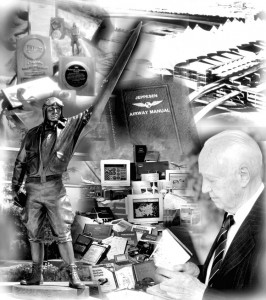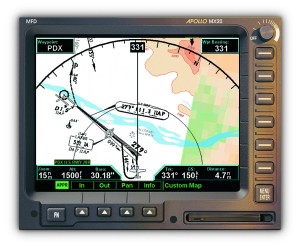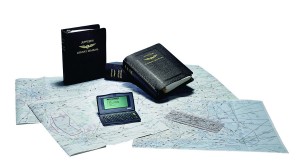By Di Freeze

Horst Bergmann, president and CEO of Jeppesen, says his four decades with the company has “definitely not been boring.”
About nine months after taking the position of president and COO of Jeppesen, Horst Bergmann took on the additional role of CEO, when predecessor Wayne Rosencrans retired.
“Our marching orders were to make sure that we had a growth rate of 10 percent a year,” Bergmann said. “A service like instrument approach charts, in a market where we could only attract instrument-licensed pilots, didn’t have that kind of a growth rate.”
Bergmann said that in the seventies, a lot of general aviation pilots went through training, but few acquired instrument licenses, due to the expense.
“And, the airlines were still hiring quite a bit from the military,” he said. “So, our growth was restricted in our market niche. We knew that we had to do something to reach our growth target, which was set by the corporate office.”
That something was to acquire other companies. Their acquisition of Bottlang Airfield Manual Company, in 1986, allowed Jeppesen to offer approach charts and airfield diagrams for VFR flying within Europe.
“That was when I was still in Germany,” said Bergmann. “That company was doing the same thing Jeppesen was doing, but only for the VFR or non-instrument pilot.”
Bergmann says that in Europe, VFR flying is a lot more restricted than in the U.S.
“There are approach procedures to every airport for VFR flights,” he said. “I can almost see this coming here in the next few years. If security goes on like this, I’m almost sure that somebody will have the idea that we have to have the same restrictions like there are in Europe. In some areas, it may make a lot of sense because of traffic. If you have specific inbound routes, holding patterns, and so forth.”
After Bottlang, more acquisitions followed. In 1987, Jeppesen acquired Lockheed DataPlan, now with offices in the United Kingdom and Los Gatos, Calif. The acquisition allowed Jeppesen to offer a complete range of flight planning and weather services.
They acquired TannGuide, renaming it JeppGuide, in 1991. That service provides pilots supplemental airport information.
“We were trying to do two things,” Bergmann said. “We wanted to enhance our financial performance but also try to buy into technologies that we did not have, which would complement our service to the same clientele, and, also, “buy skilled people.” I still think today that with all the acquisitions going on, if you do not understand very much about the business you acquire, you’d better acquire somebody with the business who understands it. Otherwise, you’re really in trouble. A lot of the people we have in management positions came from acquired companies.”
Present Day
Like other aviation-related businesses, Jeppesen was greatly impacted by the events of September 11.
“It affected us very much,” Bergmann said. “We felt an immediate impact. We were finally through 2000, with two ownership changes and a lot of distractions. … Our business was really going very well, and then, the bottom fell out of it. Mainly, because of the effect the events had on general aviation.”
Fifty percent of Jeppesen’s livelihood is general and business aviation.
“After Sept. 11, business aviation was actually going up slightly,” Bergmann said. “General aviation was non-existent, because it was grounded. We couldn’t sell a single student kit because there were no students.”
At Jeppesen, subscriptions are staggered. If a customer signs up in April, for example, they renew the following April. Immediately after Sept. 11, said Bergmann, subscription renewals “were a question mark because nobody knew if they ever could move their airplane again.”
“Those who had renewals due immediately after September were careful,” Bergmann said. “Many didn’t renew until some time later. And, it’s really difficult to say if they will all come back and renew.”
Bergmann says that subscription renewals for the first three months of 2002 were as expected.
“It was a little lower than last year’s first quarter,” he said. “We had expected 10 percent more.”

Jeppesen, founded by Elrey B. Jeppesen, is recognized as the world’s leading supplier of flight information, flight planning services, aviation weather services, maintenance information and aviation training systems.
Jeppesen was also affected due to the impact on the airline industry.
“They were not sure what they were going to do,” Bergmann said. “They didn’t buy any new airplanes. They didn’t hire any new pilots or flight attendants. So, that business was sort of flat. In addition, we decided early on that we wanted to support the industry, so we made an announcement that for the airlines we would have no price increases for a 12-month period.”
For general aviation, Jeppesen announced last fall that they would have no price increase until further notice. Bergmann says that, most likely, due to postal service rate changes, affecting them significantly, general aviation customers will see a rate increase later this year.
Another consequence of last fall has been that Jeppesen doesn’t have the revenue to go full speed ahead on projects such as one with NASA, pledged to match dollars for development on a futuristic cockpit.
“We have to balance budgets,” Bergmann said. Also, the company has been unable to give merit increases, and, due to Sept. 11, had to dismiss 121 of about 1,600 employees, worldwide.
“Those were the first lay offs at Jeppesen ever,” Bergmann said. “That was tough. I have never done it and didn’t want to do it.”
Some of those employees have been hired back. Also, Jeppesen has recently formed a new department, advanced business development, to work on the “next generation of data.”
“We have been able to hire other people with different qualifications,” he said. “We are creeping up to about 1,540 employees. We have about 40 right now in this new department, which will have about 70 people shortly.”
Bergmann said that the company lost about one full year in their development process due to Sept. 11.
“I think if we are really doing well this year, we may be able to repeat last year,” he said. “But what we really wanted to do, the growth, forget it. It’s hopefully coming in 2003 and beyond. That at a time when a lot of the technology is changing and we’re spending large amounts of money on new developments.”
Bergmann believes that the most crucial matter at hand at Jeppesen is the transition from the traditional paper product to “something else” that is as of yet undefined.
A new development in the industry is the Electronic Flight Bag.
“Once the customer makes the decision that he wants to install an Electronic Flight Bag, for example, it doesn’t help him at all if nobody has data, so we need to be there with the data,” Bergmann says.
Jeppesen started their electronic database in 1973.
“It was for flight management systems onboard airplanes,” Bergmann said. “At that time, and to a certain extent even today, they covered pertinent information for the flight path. They do not cover all of the information that a chart covers.”
At that time, Bergmann said, the database could give a pilot the frequency of a facility and bearings and distances. It could also show the aircraft’s present position within the system.

L to R: Rodi Von Barby, manager, marketing services and Ted Glogovac, product manager, international trip planning, represented Jeppesen at the recent Pacific Northwest Business Aircraft & Jet Preview.
“But they would not give you your weather minimums for your particular aircraft type, or frequencies of towers and air traffic control to contact,” he said. “They would not give you any information about obstructions, minimum altitudes, terrain, the airport lay out or runways, taxiways or parking. Even today’s systems still don’t do that.”
The “next generation,” the Electronic Flight Bag, said Bergmann, “may” do that.
“It very much depends on what the airlines want,” he said.
Besides its use for navigational purposes, the EFB can be used to store and display maintenance, technical and flight operations documents, performance, fuel, and weight and balance calculations, etc.
The portable electronic device was designed to condense varied hard copy paper material pilots carry in the cockpit into one piece of equipment.
One such device, the Fujitsu Tablet Computer, is similar to a laptop. About the size of a small stack of paper and weighing just over three pounds, it can deliver all the functions of a desktop computer and be used as a normal laptop and as a kneeboard. Onto it, a pilot will download JeppView or similar charts. Then, the computer will be linked to the instruments of the onboard navigation system.
The Tablet, said Bergmann, is now in use by a variety of people. Other devices in the developmental stage, says Bergmann, have a potential of replacing some of the instrumentation of today.
Updating these devices of the future, which might store weather, terrain, and other information, would be accomplished by a data loader, an infrared gate link or through satellite.
Bergmann said that the exact role of the EFB, however, hasn’t been completely thought out yet.
“A piece of paper is a very interesting tool,” Bergmann reasons. “I get hundreds of emails everyday. But, when I really have a long email or a long piece to read, I print it out and take it with me. I can read it on my bike in the gym. I cannot do that with my computer. If I fly someplace, I cannot open up my laptop, really, because someone in the front seat is sitting on my lap anyway. So, there are a lot of times where paper comes in very handy.”
Bergmann says that within the next several years, he isn’t sure there will be “significant change” just to electronics.
“I think it will be a mix of both; pilots like to have belts and suspenders,” he says with a smile. “And, they still have to carry the bag or put it onboard an airplane. … I think this has to be thought out very carefully. Today, each pilot has his or her bag at home. She has it in the hotel room, during layover, and can take a quick look if she is going out tomorrow to Bangkok or Hong Kong. If everything is onboard, electronically, you see it when you get to (the aircraft). … The pilot needs to be educated before she goes. She needs a chance, at least, to look at information before, and not when she is about halfway there.
“That is my philosophy and my way of thinking; I may be somewhat old-fashioned because I grew up with paper, but I think that some people will have to think about it.”
Bergmann says he wouldn’t be surprised if, in the future, you could use your palm pilot for this function.
“However, I am not sure if you want to navigate and fly an airplane with just your palm pilot,” he said. “But for information, that would be good enough.”
Bergmann predicts that one or two airlines will have gone electronic by the end of 2002.

The MX20, a multi-function display manufactured by UPS Aviation Technologies, is shown running a version of JeppView developed specifically for the MX20.
“Probably not all but at least some of their fleets,” he said. “A few people will run ahead. Others will follow in 2003 and in early 2004.
Jeppesen Employees And Locations
Jeppesen’s western hemisphere headquarters, at 55 Inverness Drive East, and a distribution center near Centennial Airport, employ over 1,000.
At headquarters, one department fields calls from about 180,000 subscribers, including flight schools and dealers, of which Jeppesen works with over 4,000 in the United States alone. Others author training and other materials, offer customer service, compile charts, print on demand, etc.
In Frankfurt, Germany, the company’s eastern hemisphere headquarters, the departments are duplicated. The one exception is that Frankfurt does not handle training materials.
At the Centennial distribution facility, employees handle photo work, plate making, printing, bookbindery work and distribution for revisions, as well as new manuals. Products are also stored in a warehouse until shipped.
Jeppesen’s operations department for the western hemisphere is in Los Gatos, Calif., near San Francisco, and for the eastern hemisphere is located at Gatwick Airport in London.
“They do computer flight planning and aviation weather services,” Bergmann said. “We have our own staff of meteorologists and international trip planners, who do dispatch and international trip planning for our business aviation customers.”
Jeppesen acquired Airspace Safety Analysis Corporation, located in Atlanta, in 1999. ASAC is the premier provider of airspace utilization and FAA compliance analysis services for the telecommunications and tower management industry.
“If you are a telecommunication company like Qwest, you have a cellular service, and you want to erect a new antenna, you come to us and we tell you where to put it,” Bergmann said. “We make sure it doesn’t penetrate air space and nobody runs into it. It has significant lights on it. It’s the right height. It doesn’t interfere with FM radio stations.”
ASAC often works with overseas governments, designing instrument approach procedures to airports and controlled air space.
An office in Washington D.C., serves as Jeppesen’s liaison to the government. Jeppesen also has two offices in Oregon. One office in Portland does the software development for moving map displays on PCs. On the opposite side of Portland is Nobeltec, which does marine navigation.
Jeppesen acquired Nobeltec, the marine mapping industry leader and the chief source for tide and current prediction information, in 2000.
“The same thing Jeppesen does for aviation, they do for the recreation and boating market,” Bergmann said.
An office in Melbourne, Australia, takes care of Australia and New Zealand. Jeppesen also has offices in Moscow and Beijing.
“We have as customers every Chinese airline there is,” Bergmann said.
Jeppesen has a unique aspect of their business they didn’t plan to get into that affects one employee in particular. Virgil Poleschook has been around the world now “a few times.” There are 17 airports in the United States that require a pilot to familiarize himself with that airport before flying a passenger aircraft into that airport.
“In the old times, that is, only a few years ago (airport quals were introduced in 1994), if you had to fly to Aspen, Eagle, Juneau, a pilot did this by a jump seat ride,” Bergmann said. “It costs time and money. Somebody wanted something cheaper. Some people developed videos. They didn’t like the videos very much because it takes, again, a lot of time. You see a video, and then for the next three months, you don’t go to the airport; you forget what it was. They came to us and said, ‘Isn’t there anything else we could do that would be a lot cheaper?'”
Jeppesen’s answer was to have Poleschook fly to Aspen and take photographs. The results were what the customer wanted. All Jeppesen had to do was convince the FAA that the photographs qualified to meet the purpose.
“The FAA looked at it and said, ‘Yes, it does,'” Bergmann said. “So, we started with the 17 U.S. airports. Now we have almost 300 worldwide, and growing, because everyone, not only U.S. airlines, all said, ‘This is great.’ It’s not a very big piece of business, but it’s a nice piece of business. And, it helps. It is just another little piece to supply services to the industry.”

Shown are Jeppesen Airway Manual, charts and the TechStar Pro, an electronic flight computer and personal organizer.
Jeppesen constantly strives to make flight planning easier. Recently, they released JetPlanner, the newest user interface for its industry-leading JetPlan flight-planning engine, making flight planning with JetPlan easier, more accessible and more cost-effective.
Ideally suited for operators requiring sophisticated flight planning functionality combined with low communications costs, the Windows-based interface comes loaded with high-resolution graphical tools and makes use of inexpensive TCP/IP communications technology.
In creating JetPlanner, Jeppesen has combined JetPlan’s capabilities with an easy-to-use graphical user interface. Included in the JetPlanner interface is a “rubberband routing” function, which gives users the ability to graphically plot and manipulate planned routings.
The company also recently unveiled EasyBrief, a JetPlan module that allows users to easily deliver preflight briefing packages, flight plans, weather and NOTAM information to flight crews at remote locations.
EasyBrief is an Internet-based crew self-briefing module that allows JetPlan users to access preflight briefing packages anywhere they have access to the Internet or a company LAN/WAN. Using browser technology and the Internet, EasyBrief saves users money by eliminating SITA and ARINC forwarding charges. In addition, EasyBrief can automatically deliver confirmation when crews retrieve briefing packages.
Bergmann has seen many changes at Jeppesen, and, he anticipates more in the future. Reflecting back on his four decades with the company, he smiles broadly.
“It has definitely not been boring,” he says.
For more information about Jeppesen products and services, please visit their website at www.jeppesen.com.











